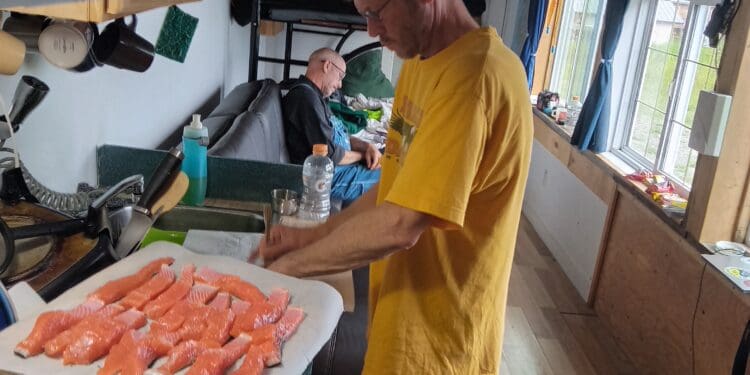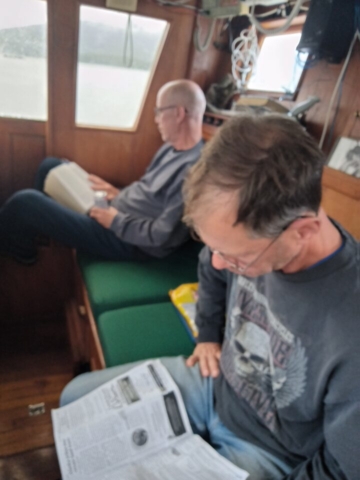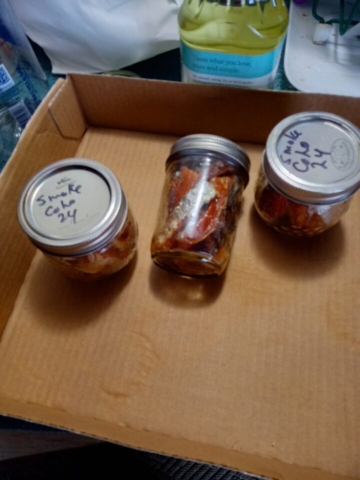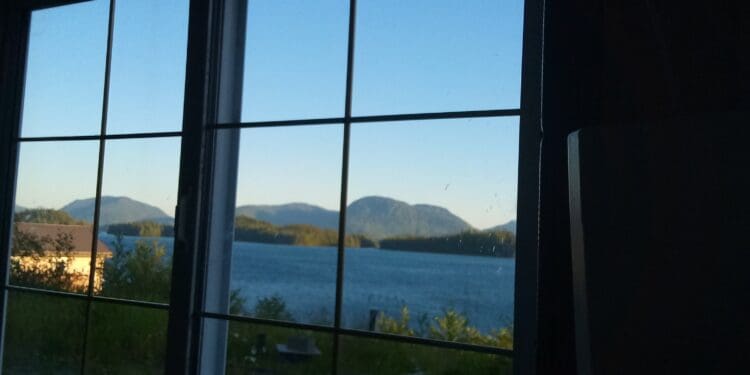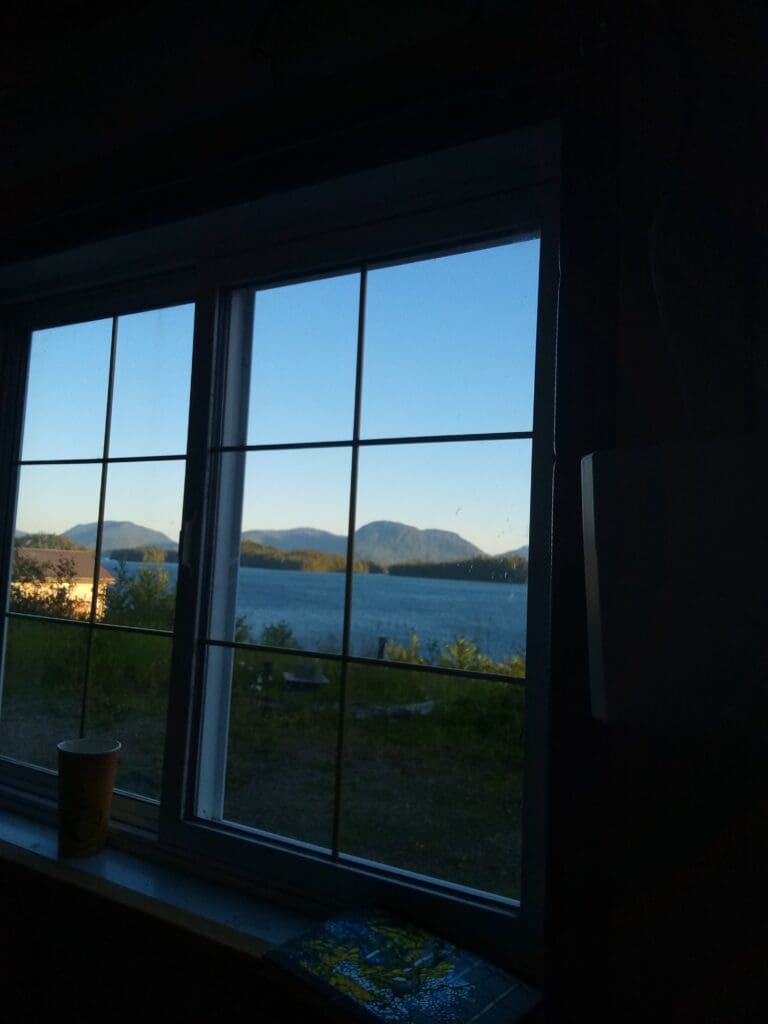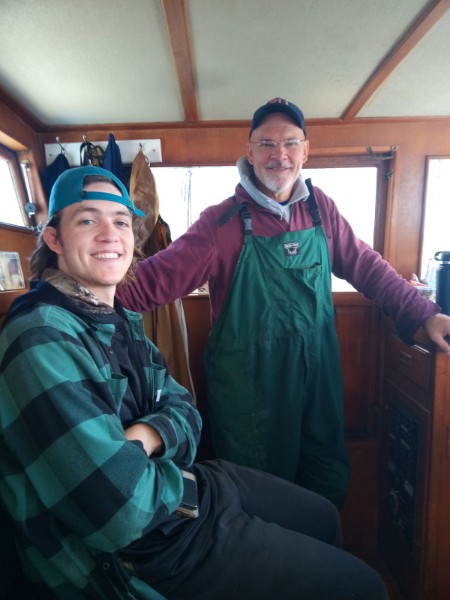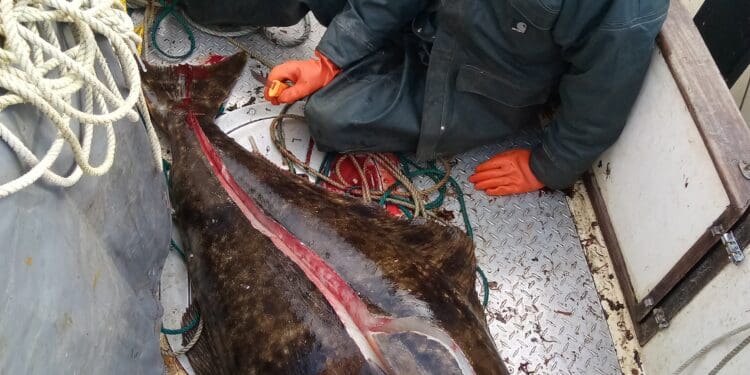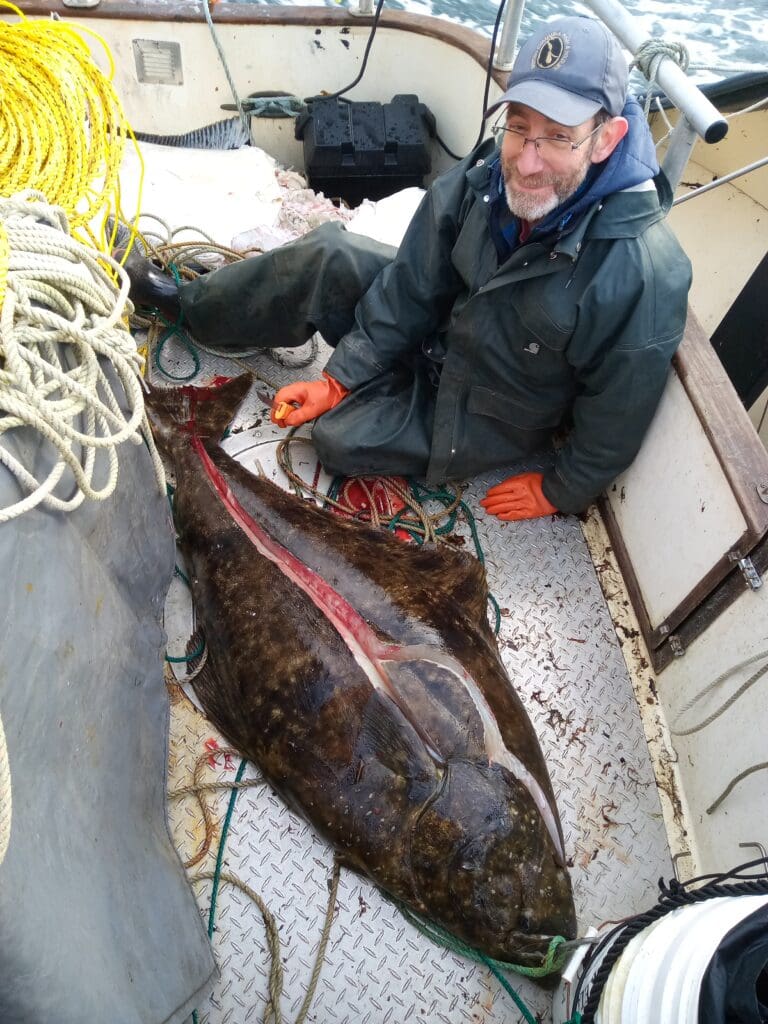Sean and Pat came in for a couple weeks of Alaska on the tug. Kind of an adventure for people to get here now rather than Juneau. Flying in on the jet from Seattle to Ketchikan is pretty routine. But then taking a small plane here, or schlocking your luggage down to the airport ferry, then down the steet a quarter mile to the Prince of Wales ferry and the 3 hour trip to Hollis are new to most.
We got out fishing and didn’t catch much the first day or two. We got a tip from Brian like we always do on where to try, and once there we caught one, but that was it. One or two humpback whales worked along the shore, and it seems like we were conscious of them and they of us, and we stayed out of each other’s way.
The next day was more of the same, with just one fish in the morning. Then Brian showed up, and his boat was catching fish one after another on the same drag as us. We lost a few but not getting nearly the action he was. He called and asked what kind of lures we were using. Spoons I said. What color? Cop car, I said. He hung up, then swung over and tossed a lure on the boat. It was black, green and blue. We put that on one rod, and on the other rod, the closest thing I had to Brian’s spoon: a green needlefish spoon I had from my trolling days that I never had caught a fish on in the waters of northern Southeast Alaska. Life got good after that.
We soon started getting kings on. Another first – never seen a specific spoon color make that much difference. We saw a lone sea lion along the shore. At one point we had a double on. Pat, the more experienced of the two, played his fish to the net, and we got it on board. Sean was letting his fish play him, with the his rod going every which direction, including all the way forward, where it slipped behind the Jeanne Kay name plate screwed to the bow. I climbed forward and released it. Sean’s line was now slack, and I feared the worst: he’d lost Brian’s spoon! But wait! There was a little weight still on the line. When the end of the line came up, the lure was still there! Along with a salmon head neatly clipped just behind the gills by that lone sea lion we’d seen. No wonder the fish was turning Sean every which way. A large mammal was on its tail, and he couldn’t get away. We found a nice anchorage in a sheltered cove on Baker island for the evening, after setting the two hook skate and the crab pot.
The next day was more of the same. I was up about 430 am and we were out fishing on the drag by about 530 am. First one’s there. The fishing was good, and we’d caught several kings by 930 am, when the bite trailed off. Rain was setting in, too. So, we reeled up and headed to check our skate (nothing) and crab pot (nothing).
The third day there was slower. We caught one big one the first pass in the morning, then that was it. Then we saw some boats across the way on the Lulu shore. Brian had told me that was another place to try, but I wasn’t quite sure just where he meant. Now I did. We picked up and got behind one of the boats to learn the drag. We got another nice fish there. Another day of learning and catching. By now, the boys had the hang of the gear. They could set the downriggers and rods alone. I would still go back to help when a fish got on, as it wasn’t yet a regular thing to get a king salmon on.
A blow was coming, and it wouldn’t be much fun fishing this spot tomorrow, so we headed for another spot that would be fishable. As we approached the channel to cross to there, I saw a big white boat. With a big red square on the side. Coast Guard. Friends called and said they’d been boarded. I love the Coast Guard and what they do. Except boarding my boat and home while I’m out on the water, armed to the teeth, without asking. We changed course and went around an island and on to town to avoid the hassle.
The next day, it did blow as expected. The first order of business was to get to the store and find the magic spoons. When we got to Log Cabin…..they had none! Dang it. I talked to Brian as we were leaving, and he said he got his at Lynn’s. Whew. We headed to JT Browns, and I found what I thought was exactly the spoon, but with a red eye on it I figured had rubbed off Brian’s spoon. I bought an extra spoon to replace the one he gave us with a new one. Sean finally got a Craig, AK hat- a JT Brown’s cap. Turns out it wasn’t exactly the spoon he gave us- they were out of those – but close enough.
We dropped the spoon off to Brian’s house door, and headed home for the day. We stopped in at Brian and Ellen’s later that day to get the key to a canoe they had stashed at a trout lake, as we thought we’d try that for the day. While there, we met a crowd from Utah who they were long time friends with – the extended family of a Utah-raised teacher friend here.
We took off the next day for the trout lake. Brian drove in his own rig as well to show us the lake location, and to collect money for some marten he’d sold to a buyer there awhile back. The lake is not easy to find, and I was sure to mark things on my gps when we made a turn on this logging road or that. He and Pat talked trapping on the way over in Brian’s truck. The boys were enchanted hiking the quarter mile through the rainforest to the lake. Brian was in the lead, and flushed a rare spruce grouse, which flew up into a tree 10 feet away and allowed us to pass. Brian lead us to the canoe, gave the boys some instructions on where to fish in the lake, and then hiked back to his truck and on for his money collection date.
The three of us boarded the canoe, with me in the middle. The boys paddled up the outlet creek into the lake, and dropped me off at a beach. We fished there together for awhile, and Pat had a little trout strike his lure right when he was about to pull it out of the water. I stayed on the beach while the boys canoed around the lake. The only other trout I saw was a 6 inch trout jump for a bug nearby. The trout seemed to have left the lake. Brian said he’d never seen the lake level so low.
We returned the canoe after a couple hours, and hiked back to the truck. I thought we’d take the back road to Coffman Cove, where the hamburger stand is. We stopped at the liquor store and got directions to the road, which we easily found and soon were on our way. The road is gravel, with the usual pot holes and washboards. It runs about 30 miles along the coast to Coffman Cove. We stopped to watch some whales at one spot, and I discovered another sea asparagus patch, which I noted on my phone GPS. An hour later we were almost to the junction with the Coffman Cove road and blessed pavement when we came on a landslide across the road! I thought: this must have just happened! Otherwise, surely the Forest Service would have put up a sign on the road in Thorne Bay notifying others like us the road was impassable. So, around we turned.
On the way back, we came on a group of 20 somethings playing frisbee golf, of all things, about half way back to Thorne Bay. I asked them where they were from. Craig, they said. Did they know there was a landslide on the road? Oh sure. It’s been there awhile. Must take an act of Congress for the Forest Service to put a courtesy road sign, I guess.
The next day, I wasn’t feeling too peppy. A slight fever and cough. Uh oh. I don’t get sick. Just never have. I found a COVID test trusty Sara had left here, and that confirmed the cause of my sickness. I called Ellen and told her. A couple of the Utah crowd were sick. Brian got it the next day. We didn’t see the need for the 3 of us to isolate since we’d spent the previous day cooped up in the truck in close proximity. Sean then tested positive. Still not sure who gave it to who, but it was a one day thing, and much less severe than the other time I knew I had COVID. Thanks goodness for the vaccine and the boosters.
I felt a little better the next day, and the boys were up for leaving on the tug again. Get us out of town and keep the spread from us to a minimum. We headed to the anchorage where we can fish in most weather. I think we caught a few fish there the next day. The weather was flat, so on Brian’s advice (again!) we headed for the outer coast to fish the incoming tide late in the afternoon. We’d have added bonus of being there when the dozens of charter boats out there would have to be heading back to their lodges, so we’d have the place more to ourselves. We caught a nice 22 lb king salmon, and a couple large dusky rockfish we had for dinner. We returned to the inside anchorage, and set the skate.
The next day, it was pouring rain and blowing. We weren’t fishing the outside today. We stayed on anchor all morning while it blew. The wind laid down a bit in the afternoon as forecast. So we fished right by the anchorage. The fish were there. We caught four fat coho, a nice king, and lost a bigger king. When we checked the skate, we had a 25 lb halibut, and reset the skate. What a day.
The next day we fished the same spot. I was up early so we’d be fishing as the same tide stage as yesterday afternoon. Lots of feed showed on the sounder. We made two trips around the drag. Nothing but two little rockfish! A blow was coming again the next day, so we headed home. We checked the skate on the way out. The sixth halibut of the season at this spot. But the sand fleas had gruesomely killed the chicken halibut on the hook, and I shook it off. We decided to try to fish with the rods for halibut right there, as we’d caught so many halibut this season. Only the boys could fish with rods, as a person can’t fish a personal use skate and sport rods the same day. Nothing there. Not a bite.
I looked on the chart, and saw a promising (to me) spot not far away, so we moved there. We were fishing one side of a rock in about 120 feet of water. We could see a couple local boats fishing on the other side of the rock in 250 feet of water. We fished for about an hour and not a bump. Then I started hearing some blows. I looked for the source and saw them: orcas. Behind the boats on the other side of the rock.
We cranked up our fishing gear and I headed that way. My boat does about 6 knots, so I wasn’t sure I could catch them if they were cruising.
We cruised in their direction, and soon were about 150 yards away or so, and I put the boat in neutral to watch. The whales were not cruising, but appeared to be circling and slashing and feeding somehow. I wasn’t sure on what. I saw some bullkelp on the water amongst them, but that was it.
The whale activity started edging our way. I backed up to stay away. When the whales surfaced closer, I put the boat in neutral per my whale watch boat captain experience. The whales edged even closer, as did the stipe of bull kelp in the center of their activity. Then the whales were 50 yards and closing. I shut the engine down. Now I saw it: that stipe of bullkelp wasn’t bullkelp. It was a seal! And that seal was being used by the group (I think – what do I know – I’m not an orca) – to train the calf in the group.
The largest whale would turn quickly and slap it’s tail. I witnessed this close to the boat sometime later and can tell you what that was about. Each time he whipped his tail, it came down precisely on top of that poor seal. I would think the concussion would kill it. But it did not. The seal would surface afterword.
The seal came right up to our boat with huge, tired, bloodshot eyes. It tried to hide between our bumper buoys hanging over the side. The killer whales were now circling right next to the tug. They would roll on their side and look up at us. And at the seal. If the punt wasn’t pulled up on the swimstep, I think the seal would have piled up there in a second. The orcas were slashing around the boat. In the front. On the sides. On the stern. On the bow. Then, with the seal snuggled alongside the boat, three of the whales surfaced a few boat links away, and just sort of stared at us and the seal. All in a line. Ready to charge. I was pretty nervous and creeped out. Sean was on the bow, and I told him to stay in the center and not get near the side of the boat. These orcas are savage.
The whales went below the surface for a minute or two, and that was all I could take. I cranked up, and headed back towards the rock, between the two boats fishing there, leaving the seal behind. We saw the whales soon surface behind us, and again continue to molest the seal. The largest whale repeatedly slapping its tail precisely on the seal. Pat told me later he saw some of the younger whales trying to do the same thing, but they didn’t hit the seal everytime like the biggest whale did.
The whale group and seal came our way slowly. We saw the whales all in the group. The seal had it’s head above water, but it looked like it was clearly in the mouth of one of the whales and not under it’s own power. Then there was a swoosh, and the seal disappeared. It did not reappear. Eventually, the whales moved on. Devilfish. A perfect nickname for these creatures. Or f$*9ing bastards, as I called them. I think it’s the first time I’ve ever felt sorry for a seal.
We came back to town for good on Thursday, as the boys left on the ferry Sunday morning. On Friday, I showed the boys how I smoke fish and can them. I learned how to can fish from Heather Stillwell on the Nushagak River in the late 1980’s. I was a fishing guide living in a camp on the river for Wood River Lodge, and Heather was running the fish counting sonar camp for ADFG upriver. For the smoking part, I learned this from Paul’s daughter Nevette, who learned it from her friends in Yakutat while she fished on the Alsek River. The smoking part is an art that can entail any number of variations and still come out right. The canning part is science that needs to be followed precisely, else botulism could result that can kill a person if they eat tainted fish.
Sean is pretty fastidious, and took to the whole process with interest. Pat already knows alot of the process from smoking and curing venison sausages and bologna in Bolivar. Both of them understand “process” from making maple syrup at the Dunn sugar house. I thawed out some coho salmon, and cut it into strips, brined the strips, then had Sean put them on the smoker racks. We loaded my makeshift smoker, and started the low heat to dry the fish. When it was tacky, I added a piece of peeled alder every now and then for some smoke.
Ellen cooked dinner for us- bison and halibut enchiladas. She and Brian and the boys talked hunting, fishing, trapping and maple syrup making for a couple hours. Dessert was sourdough waffles with fruit and the boys’ syrup.
This morning, the fish were finished smoking, and I showed Sean how to measure and cut the strips and pack the canning jars. Then I showed him the steps for canning, and also texted he and Pat the files from UAF for safe canning of smoked fish.

